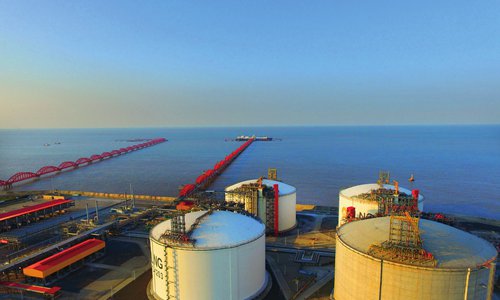SOURCE / INDUSTRIES
PipeChina pursues LNG network, more projects expected in H2
PipeChina pursues LNG facilities, more gas supplies

A view of the PetroChina Jiangsu LNG receiving station at the Yangkou Port in Nantong, East China's Jiangsu Province. The station ranks first in terms of receiving frequency and capacity of LNG container ships in China. Photo: VCG
China launched a new construction project of a liquefied natural gas (LNG) terminal on Saturday, the first operating project since the establishment of China Oil & Gas Piping Network Corp (PipeChina) in December last year. The project shows that the nation continues to invest in the energy sector despite disruptions caused by the COVID-19 pandemic.
Located in Longkou, a coastal city in Yantai, East China's Shandong Province, the new LNG terminal is expected to handle 20 million tons of LNG and supply some 28 billion cubic meters of natural gas a year.
The total investment of the project was worth 35 billion yuan ($5 billion). Its first phase is scheduled to open in 2023, according to PipeChina.
It is estimated that the project will help Shandong Province cut carbon dioxide emissions by 32 million tons per year.
As a key LNG project in the Bohai Sea region, the Longkou facility will provide continuous, stable and clean natural gas while enhancing peak shaving capacity and providing emergency storage. It will also ensure winter supplies of natural gas for Shandong, regions around the Bohai Sea and northern China.
Industry analysts told the Global Times that China plans to expand the capacity of LNG deposit stations and increase peak storage capacity for natural gas via a "connected nationwide network," in which PipeChina will play a significant role.
The pipelines operated by the three oil giants - CNOOC, China National Petroleum Corp (CNPC) and Sinopec Group - were combined into PipeChina in December in a move to improve efficiency and guarantee supplies. It's an important step in promoting the reform of China's oil and gas sector.
The average annual growth rate of China's natural gas pipeline network in terms of length was 5.9 percent from 2015 to 2018. But that fell short of the 10.2-percent target set in the 13th Five-Year Plan (2016-20), according to Liu Manping, a senior economist of the price monitoring center of the National Development and Reform Commission, China's economic planner.
Liu told the Global Times that the Longkou project is the first case of genuine operations by the new unified network since its establishment, and it will accelerate the construction of pipeline infrastructure.
The Global Times learned that the Longkou project was owned by CNOOC before being transferred to PipeChina, a move that shows progress by the new company in carrying out asset transfers, according to Liu.
"Apart from projects that previously belonged to the three oil giants, PipeChina will likely explore more projects on its own," Lin Boqiang, dean of the China Institute for Studies in Energy Policy at Xiamen University, told the Global Times on Sunday.
"The COVID-19 pandemic might delay work on PipeChina's new projects, but in the second half of 2020, PipeChina will likely build more projects," Lin said.
However, PipeChina still faces some difficulties such as the divestiture of assets and transfer of employees.
"When it comes to transferred assets from the listed companies of CNPC, Sinopec and CNOOC, PipeChina must carefully balance small shareholders' interests and choose transparent methods to value the assets," Lin said
Improving staff efficiency is another challenge, since most of those people came from the three oil giants, he added.



